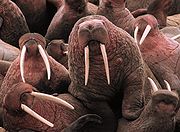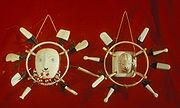
Walrus ivory
Encyclopedia



Walrus
The walrus is a large flippered marine mammal with a discontinuous circumpolar distribution in the Arctic Ocean and sub-Arctic seas of the Northern Hemisphere. The walrus is the only living species in the Odobenidae family and Odobenus genus. It is subdivided into three subspecies: the Atlantic...
tusk ivory
Ivory
Ivory is a term for dentine, which constitutes the bulk of the teeth and tusks of animals, when used as a material for art or manufacturing. Ivory has been important since ancient times for making a range of items, from ivory carvings to false teeth, fans, dominoes, joint tubes, piano keys and...
comes from two modified upper canines. The tusks of a Pacific walrus may attain a length of one meter. Walrus teeth are also commercially carved and traded. The average walrus tooth has a rounded, irregular peg shape and is approximately 5cm in length.
The tip of a walrus tusk has an enamel
Tooth enamel
Tooth enamel, along with dentin, cementum, and dental pulp is one of the four major tissues that make up the tooth in vertebrates. It is the hardest and most highly mineralized substance in the human body. Tooth enamel is also found in the dermal denticles of sharks...
coating which is worn away during the animal's youth. Fine longitudinal cracks, which appear as radial cracks in cross-section, originate in the cementum and penetrate the dentine. These cracks can be seen throughout the length of the tusk. Whole cross-sections of walrus tusks are generally oval with widely spaced indentations. The dentine is composed of two types: primary dentine and secondary dentine (often called osteodentine). Primary dentine has a classical ivory appearance. Secondary dentine looks marble or oatmeal-like.
Walrus ivory carving and engraving has been an important folk art for people of the Arctic
Arctic
The Arctic is a region located at the northern-most part of the Earth. The Arctic consists of the Arctic Ocean and parts of Canada, Russia, Greenland, the United States, Norway, Sweden, Finland, and Iceland. The Arctic region consists of a vast, ice-covered ocean, surrounded by treeless permafrost...
since prehistoric times, among them the Inuit
Inuit
The Inuit are a group of culturally similar indigenous peoples inhabiting the Arctic regions of Canada , Denmark , Russia and the United States . Inuit means “the people” in the Inuktitut language...
, Inupiaq and Yupik of Greenland and North America and the Chukchi
Chukchi people
The Chukchi, or Chukchee , ) are an indigenous people inhabiting the Chukchi Peninsula and the shores of the Chukchi Sea and the Bering Sea region of the Arctic Ocean within the Russian Federation. They speak the Chukchi language...
and Koryak
Koryak
Koryak may refer to:*Koryak Autonomous Okrug, a federal subject of Russia*Koryaks, a people of northeastern Siberia*Koryak language, language of the Koryaks*Koryak, the illegitimate son of Aquaman, a fictional character in DC Comics...
of Russia
Russia
Russia or , officially known as both Russia and the Russian Federation , is a country in northern Eurasia. It is a federal semi-presidential republic, comprising 83 federal subjects...
. The Chukchi and Bering Sea Yupik in particular continue to produce ivory. During Soviet
Soviet Union
The Soviet Union , officially the Union of Soviet Socialist Republics , was a constitutionally socialist state that existed in Eurasia between 1922 and 1991....
times, several walrus carving collectives were established in villages in Chukotka
Chukotka Autonomous Okrug
Chukotka Autonomous Okrug , or Chukotka , is a federal subject of Russia located in the Russian Far East.Chukotka has a population of 53,824 according to the 2002 Census, and a surface area of . The principal town and the administrative center is Anadyr...
, notably Uelen
Uelen
Uelen is a rural locality in the Chukotsky District, just south of the Arctic Circle in Chukotka Autonomous Okrug in the Russian Far East. Population: 776 in 2003, with 595 Chukchi and 72 Yupik. Located near Cape Dezhnev where the Bering Sea meets the Chukchi Sea, it is the easternmost settlement...
. International trade is, however, somewhat restricted by the Convention on the International Trade of Endangered Species (CITES).
The folk art of walrus ivory carving has been popular in European Russia
Russia
Russia or , officially known as both Russia and the Russian Federation , is a country in northern Eurasia. It is a federal semi-presidential republic, comprising 83 federal subjects...
since the Middle Ages, with notable schools of walrus ivory carving in Kholmogory
Kholmogory
Kholmogory is a historic village and the administrative center of Kholmogorsky District of Arkhangelsk Oblast, Russia. It lies on the left bank of the Northern Dvina, along the Kholmogory Highway, 75 km southeast of Arkhangelsk and 90 km north of the Antonievo-Siysky Monastery. The name...
and Tobolsk
Tobolsk
Tobolsk is a town in Tyumen Oblast, Russia, located at the confluence of the Tobol and Irtysh Rivers. It is a historic capital of Siberia. Population: -History:...
. The Norse also carved items in walrus ivory, notably the Lewis chessmen
Lewis chessmen
The Lewis Chessmen are a group of 78 12th-century chess pieces, most of which are carved in walrus ivory...
.

